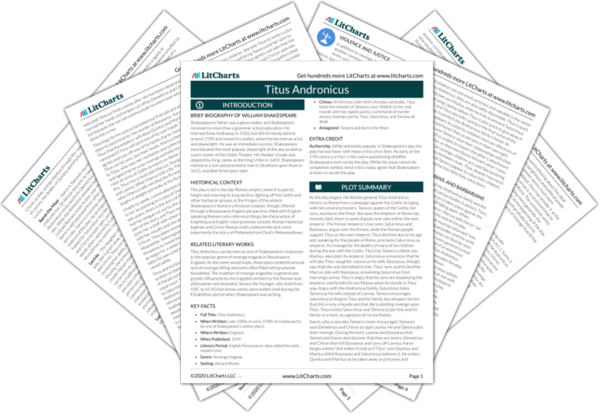Brief Biography of William Shakespeare
Shakespeare's father was a glove-maker, and Shakespeare received no more than a grammar school education. He married Anne Hathaway in 1582, but left his family behind around 1590 and moved to London, where he became an actor and playwright. He was an immediate success: Shakespeare soon became the most popular playwright of the day as well as a part-owner of the Globe Theater. His theater troupe was adopted by King James as the King's Men in 1603. Shakespeare retired as a rich and prominent man to Stratford-upon-Avon in 1613, and died three years later.
Historical Context of Titus Andronicus
The play is set in the late Roman empire, when it is past its height and entering its long decline, fighting off the Goths and other barbarian groups at the fringes of the empire. Shakespeare’s Rome is a fictional creation, though, filtered through a Renaissance English perspective, filled with English-speaking Romans who reference things like the practice of knighting and English-style grammar schools. Roman historical legends and Greco-Roman myth underpin the plot, most importantly the story of Philomela from Ovid’s Metamorphoses.
Other Books Related to Titus Andronicus
Titus Andronicus can be seen as one of Shakespeare’s responses to the popular genre of revenge tragedy in Renaissance England. As the name would imply, these plays centered around acts of revenge-killing and were often filled with gruesome bloodshed. The tradition of revenge tragedies in general was greatly influenced by the tragedies written by the Roman stoic philosopher and dramatist Seneca the Younger, who lived from 4 BC to 65 AD but whose works were widely read during the Elizabethan period when Shakespeare was writing.
Key Facts about Titus Andronicus
-
Full Title: Titus Andronicus
-
When Written: Late 1580s or early 1590s (it is believed to be one of Shakespeare’s earlier plays).
-
Where Written: England
-
When Published: 1594
-
Literary Period: English Renaissance (also called the early modern era)
-
Genre: Revenge tragedy
-
Setting: Ancient Rome
-
Climax: At the feast with which the play concludes, Titus feeds the remains of Tamora’s own children to her and reveals who has raped Lavinia; a whirlwind of murder ensues, leaving Lavinia, Titus, Saturninus, and Tamora all dead.
-
Antagonist: Tamora and Aaron the Moor.
Extra Credit for Titus Andronicus
